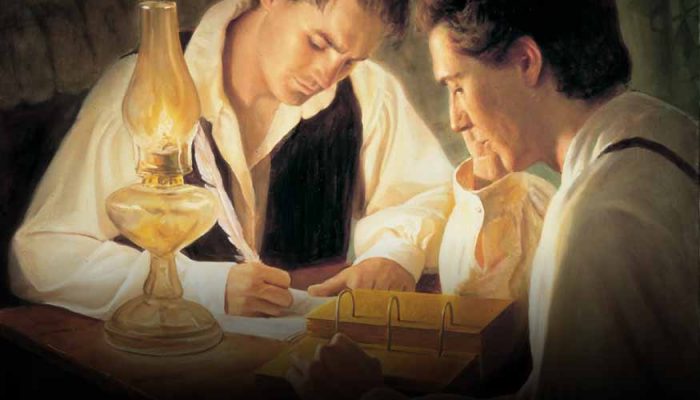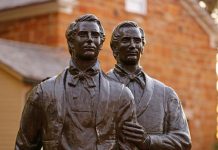
The Church of Jesus Christ of Latter-day Saints (often inadvertently referred to as the “Mormon Church”) has a fascinating and very instructive history. Latter-day Saints (“Mormons”) believe that Joseph Smith was called of God to restore the fullness of the gospel of Jesus Christ, which had been lost from the earth. The organization of The Church of Jesus Christ of Latter-day Saints took place on April 6, 1830 (with just six original members), but there were several significant events which took place leading up to that day as well as many significant events which continued to shape the structure and doctrine of the Church which took place after that day. Restoring the gospel in its entirety was a monumental task and could not be done overnight.
When one studies the life of Joseph Smith in more detail, it becomes obvious that from a very young age, Joseph was intended for a great work. The adversary worked against him very hard, hoping to destroy the person God had chosen for such an immense task. Through faith and strength, though, Joseph persevered. When he was only 14 years old, Joseph earnestly sought an answer from God about which church he should join. The religious turmoil in the region (the Second Great Awakening in the northeastern U.S.) was intense and religion was something Joseph took very seriously. He never dreamed that in answer to his innocent, earnest prayer that he would receive a heavenly visitation.
God the Father and His Son, Jesus Christ, both appeared to Joseph Smith and told him that none of the churches on the earth at that time had the fullness of the gospel of Jesus Christ. Thus, he should not join any of them. Three years later, again in response to earnest prayer, Joseph Smith received another heavenly visitation, this time from an angel named Moroni. Over the next several years, Joseph received visitations from myriad heavenly messengers who taught him and instructed him. He was given a divine mandate, as well as divine aid, to translate an ancient record of Jesus Christ’s dealings with some of the inhabitants of the ancient Americas. He was given revelation on gospel matters as he sought further instruction through prayer. These revelations resulted in the restoration of the priesthood (the power and authority to act in God’s name), which had been lost from the earth millennia ago.
The record Joseph was translating was published as the Book of Mormon in late March of 1830. Soon thereafter, the church was organized. Joseph and those who believed and followed him met with strong, often violent, opposition as soon as Joseph’s claim to his first heavenly vision was made known. Despite the many people who recognized the truth in the restored gospel and who flocked to the waters of baptism by those who had authority, opposition continued to grow.
The history of the Saints is filled with stories both tragic and inspiring. There are so many people who sacrificed so much to follow their faith. Some left worldly possessions behind, others were ostracized from their families when they joined the church. Saints who gathered together for support met with mob violence and persecution. Many Saints were driven from their homes multiple times.
Joseph Smith did his best to lead those who believed he was divinely called and appointed, but he was a man. He was imperfect and fallible. This humanity caused some of those closest to him to call him a fallen prophet and turn against him, sometimes joining mobs who continued to persecute the Saints. Notwithstanding almost countless betrayals, Joseph never turned bitter. He loved people and freely forgave. Each time the Saints were driven out of their homes, Joseph did the best he could to lead them to a new place where they could worship God according to the dictates of their own consciences.
The opposition never abated, however, and misunderstandings led to even more hate and anger. On June 27, 1844, after Joseph was arrested yet again on false charges, a mob attacked the jail where Joseph Smith, his brother Hyrum Smith, and others were being wrongfully held. Joseph and Hyrum were both shot and killed. Enemies of the Saints thought this would put an end to the church they hated with such inexplicable fervor. They were wrong.
Joseph Smith was called of God to do a great work, and he fulfilled that work. However, Joseph was also assured that “no unhallowed hand can stop the work from progressing; persecutions may rage, mobs may combine, armies may assemble, calumny may defame, but the truth of God will go forth boldly, nobly, and independent, till it has penetrated every continent, visited every clime, swept every country, and sounded in every ear; till the purposes of God shall be accomplished, and the Great Jehovah shall say the work is done” (“The Wentworth Letter,” Joseph Smith, March 1, 1842). No one could stop his work from being completed, because it was not his work; it was and is God’s work.
Brigham Young became the next president and prophet of The Church of Jesus Christ of Latter-day Saints, and he led the Saints west to a desert no one wanted, where he hoped they would be left alone. Their belief system varied so widely, in some respects, to others’ that they were destined to not be left alone. Armies attacked them, the government tried to subdue them, enemies in Congress tried to disenfranchise the Church and its members, but the Saints carried on.
There are some things in Mormon history that make people uncomfortable. Some things make people who are not members of the Church uncomfortable because of the countless unconstitutional actions that were taken against the Saints, while those who should have protected them stood by and allowed them to be persecuted. Other things make people who are members of the Church uncomfortable, because they discover that the early Saints were not perfect, including Joseph Smith and Brigham Young. Indeed, some people in the Church’s history made horrible decisions which resulted in tragedy. Other decisions just seem so foreign to our way of life, like polygamy, that they seem to not be right, though an objective view of things could show us that they really aren’t inherently wrong. Mormon history, although short, puts on full display the possible nobility and foibles of human nature, both among Mormons and the people who persecuted them. The doctrines, however, are of God, and they are true. The Church of Jesus Christ of Latter-day Saints is God’s true and living church with the power and authority to act in His name. The head of the Church is Jesus Christ Himself. In the history of the Church one can see Satan raging in the hearts of men, to defame the Church, to twist and misrepresent its doctrines.
It is healthy to know the facts, both good and bad, because we can learn from others’ successes as well as their mistakes. Learning more about where we come from is healthy and can be very faith promoting. However, what is far more important is one’s personal faith in Jesus Christ. The history isn’t unimportant, but it is far less important than our faith and what it is based on.
Mormonism’s purpose is to bring us closer to God through the atonement of Jesus Christ. God has a plan for His children, and that is for all of His children who choose to, to return to live with Him again. The doctrine and the covenants of The Church of Jesus Christ of Latter-day Saints show us exactly what we need to do if we do wish to return to God. It is a path that requires sacrifice and dedication, but the blessings for making those “sacrifices” show us how much more to our benefit it is to cut the things out of our life that keep us from drawing nearer to God than it is to let those things keep us from becoming more like our Savior.
Jesus Christ said, “By their fruits ye shall know them” (Matthew 7:20). Living the gospel of Jesus Christ is its own reward. Anyone who looks at the lives of those people who follow the teachings of Jesus Christ can see that it makes people’s lives better. The Church of Jesus Christ of Latter-day Saints gives people the tools they need to apply the teachings of Jesus Christ in their lives and to become more like Him.
If you would like to learn more about specific events and people in Mormon history, please visit historyofmormonism.com, which deals far more in depth with the history of the Church. At historyofmormonism.com, you will also find personal journal accounts from early members of the Church that reveal their hardships, their faith, and indeed, the personal revelations that helped them face such bitter trials and emerge triumphant.





